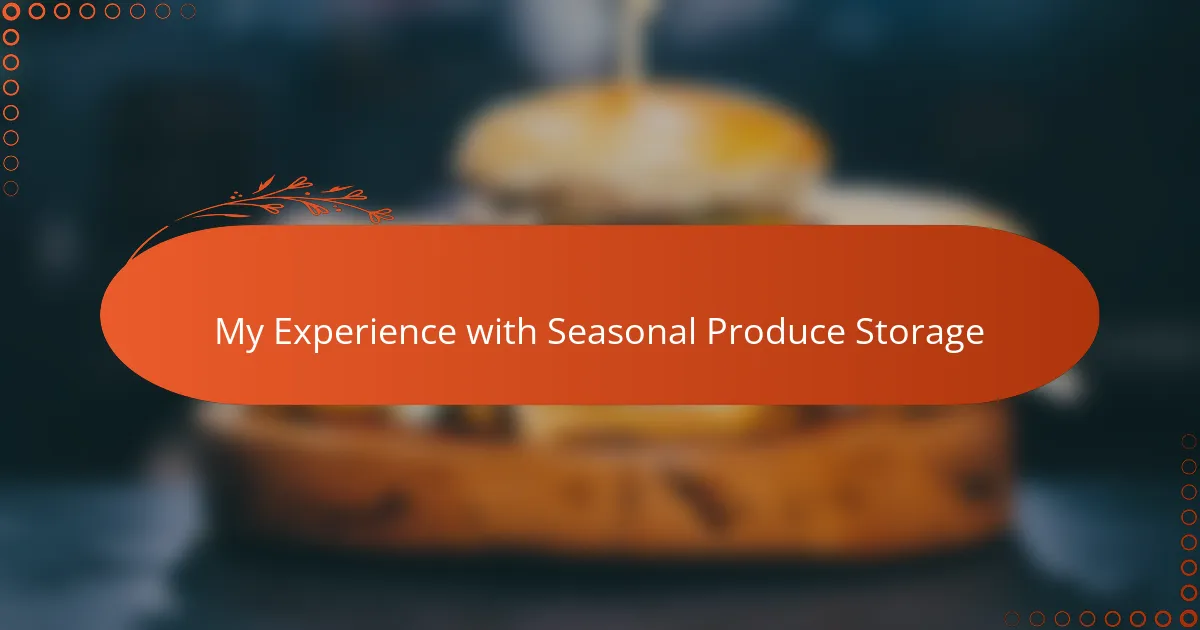Key takeaways
- Proper storage of seasonal produce involves understanding temperature, humidity, and ethylene gas effects to enhance freshness and reduce waste.
- Essential tools for storage include breathable bags, thermometers, and bins to organize produce while preventing bruising.
- Prep techniques, such as washing, drying, and sorting by ripeness, significantly extend the shelf life of fruits and vegetables.
- Using stored produce enhances meal flavor and reduces food waste, promoting a sustainable cooking experience throughout the year.
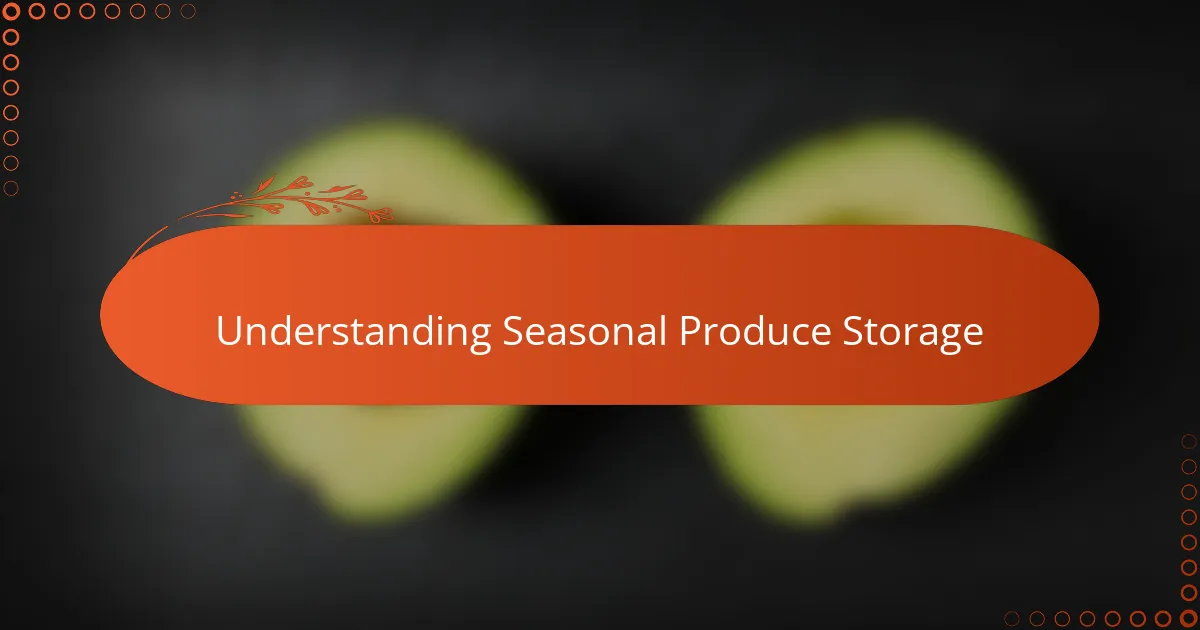
Understanding Seasonal Produce Storage
When I first started storing seasonal produce, I quickly realized that each fruit and vegetable has its own preferences for temperature and humidity. Knowing whether something likes to be cool and dry or moist and warm makes a huge difference in how long it lasts. Have you ever bought a bunch of fresh greens only to find them wilting in a day? That’s usually because they weren’t stored properly for their specific needs.
Understanding the science behind produce storage was eye-opening for me. For example, did you know that some fruits release ethylene gas, which can cause nearby vegetables to spoil faster? This little fact changed how I arrange my fridge and pantry completely. It made me appreciate the delicate balance required to keep everything fresh longer.
It’s not just about preservation; it’s about respecting the life cycle of each item and letting it rest in the right conditions. I tend to think of it as a form of conversation with nature—listening and responding to what my harvest needs rather than forcing it into a one-size-fits-all solution. That mindset has made my time in the kitchen both more enjoyable and less wasteful.
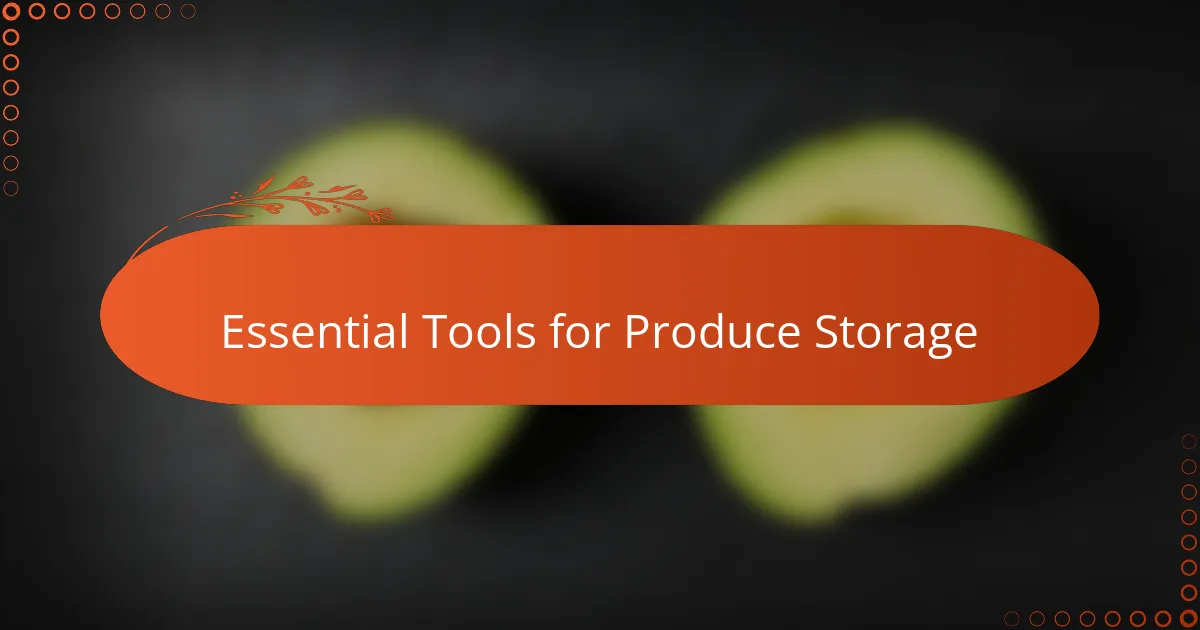
Essential Tools for Produce Storage
One tool I can’t live without when storing my seasonal produce is a good set of breathable storage bags. At first, I used regular plastic bags, but I noticed my vegetables would sweat and spoil faster. Switching to mesh or perforated bags felt like giving my greens a little room to breathe, and the difference was immediate.
Another essential for me has been a quality thermometer and hygrometer combo. You might wonder why I bother measuring the exact temperature and humidity in my storage spaces, but trust me, it’s a game changer. Knowing when the air is too dry or too moist helps me adjust conditions, so my apples stay crisp and my carrots don’t go limp.
Finally, I rely on sturdy bins and shallow crates lined with soft cloth or newspaper. These keep the produce organized without bruising delicate items. Early on, I learned the hard way that piling everything in one big box leads to squished tomatoes and sad potatoes. Now, with these tools, my harvest stays happy and healthy much longer.
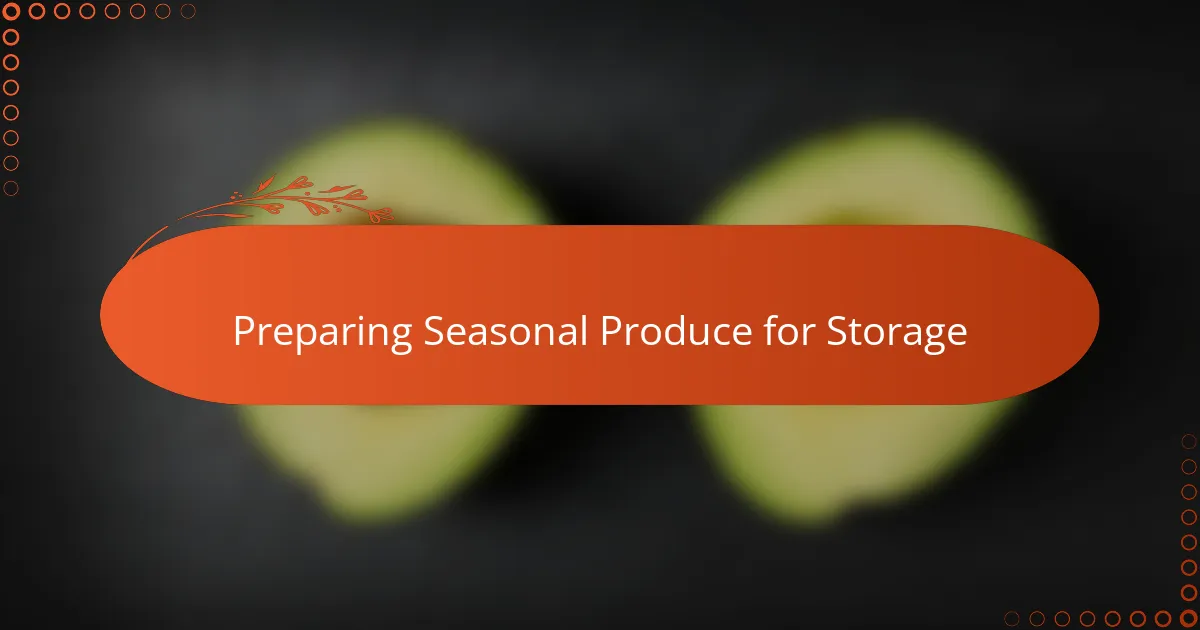
Preparing Seasonal Produce for Storage
Before storing my seasonal produce, I always take the time to wash and thoroughly dry each item. I remember one season when I skipped drying my herbs properly, only to find them moldy within days. That taught me the hard way that moisture at the start can cut down storage time dramatically, so now I’m extra careful.
Sorting the produce by ripeness is another step I never overlook. Have you ever tried storing overly ripe tomatoes next to firm ones, only to find everything spoiled quickly? I sure have, and it showed me that grouping similar ripeness levels helps everything last longer and reduces waste.
Peeling and trimming is also part of my prep routine for root vegetables and squash. Years ago, I hesitated to do this, thinking it might shorten shelf life, but I found that removing damaged skin and cutting off unwanted parts actually slowed deterioration. It’s a small effort that pays off big in keeping produce fresh and ready for my recipes.
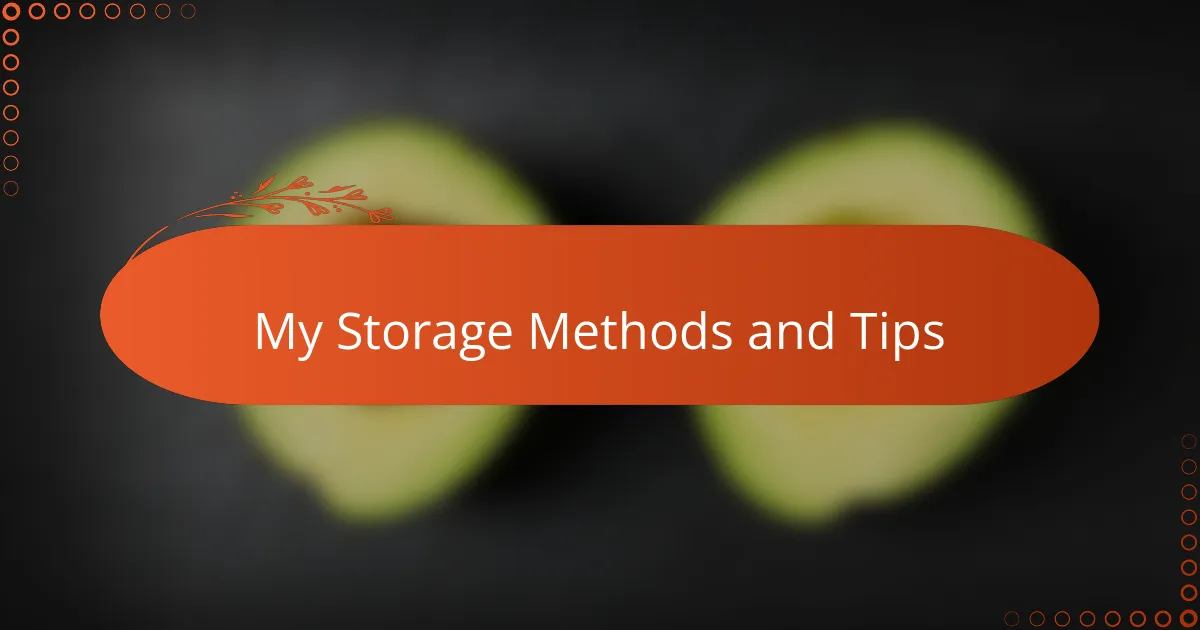
My Storage Methods and Tips
One method I swear by is using paper towels to line my storage containers, especially for leafy greens. It sounds simple, but this little tip keeps excess moisture at bay and prevents that dreaded slimy texture. Have you ever pulled out a bunch of lettuce only to find it soggy and sad? That’s exactly what this trick helps me avoid.
I also like to keep ethylene-producing fruits like apples and pears separate from sensitive veggies such as broccoli and carrots. Early on, I neglected this and ended up with a mess of spoiled produce. Now, arranging my storage thoughtfully feels like a protective ritual for my harvest, ensuring everything stays crisp and vibrant for longer.
Lastly, I make it a habit to check on my stored goods weekly, not just to see what’s going bad but to rearrange and remove any items that might speed up spoilage. It might sound time-consuming, but this small investment of time saves me from bigger losses. Plus, it gives me a chance to reconnect with what I’ve grown and plan my meals more mindfully.
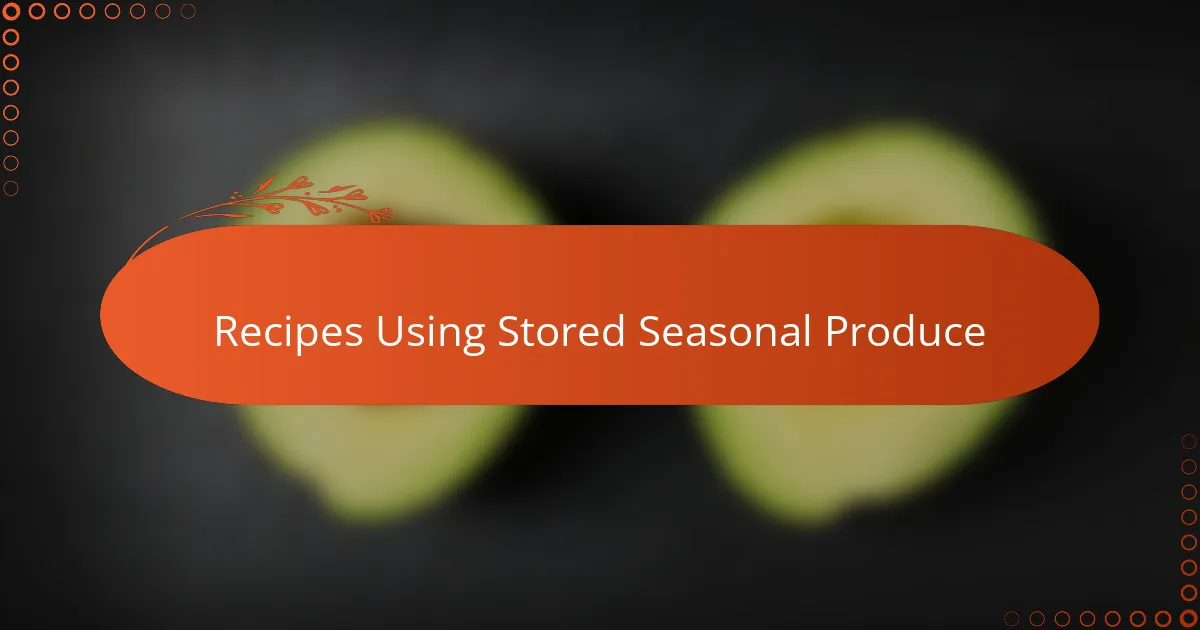
Recipes Using Stored Seasonal Produce
When I started cooking with stored seasonal produce, I realized just how much flavor can deepen after a period of proper storage. One of my favorite go-to recipes became a roasted root vegetable medley—using carrots, parsnips, and beets I had kept in my cool cellar. Have you ever tasted sweetness intensify in a carrot that’s been patiently stored? It’s a revelation that changed how I approach simple meals.
I also discovered that soups and stews are perfect for using up produce that’s been stored a bit longer but still retains good texture. Last winter, I made a creamy butternut squash soup using squash from my storage bins, and it was not only comforting but packed with that slow-harvested richness. These recipes turned my stored goods into hearty meals that felt like a warm hug on cold days.
Finally, don’t underestimate the power of quick pickling for preserved cucumbers or radishes. I started doing small batches to add brightness and crunch to sandwiches and salads throughout the off-season. It’s such a satisfying way to extend the life of your harvest while adding zest and variety to everyday dishes—what’s not to love about that?
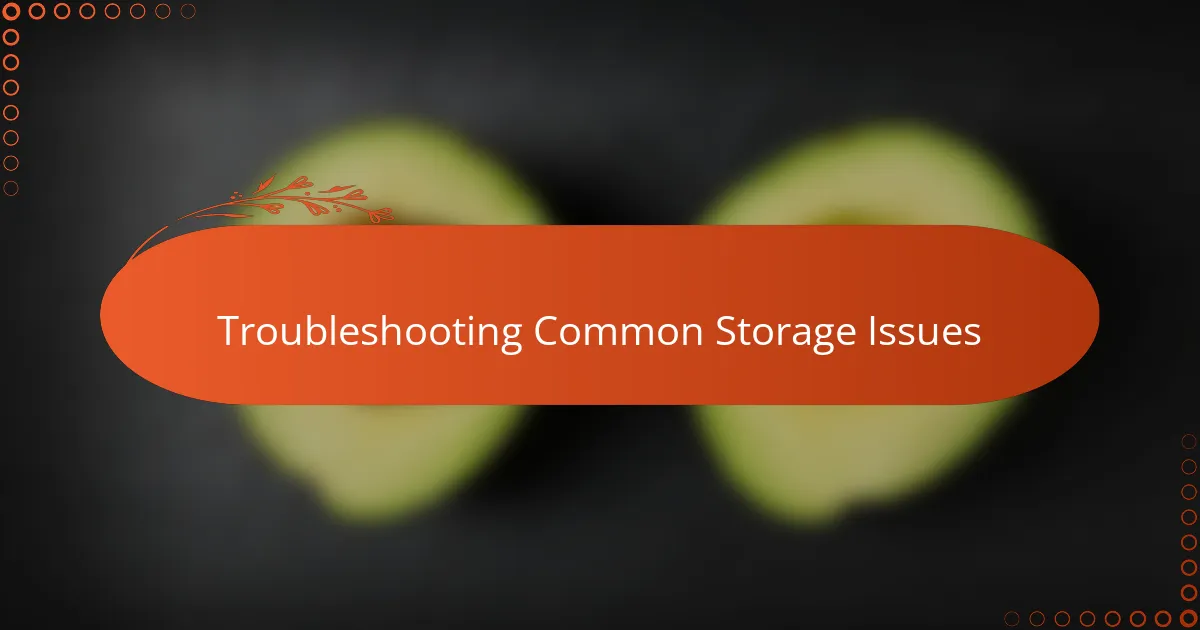
Troubleshooting Common Storage Issues
One challenge I often faced was dealing with unexpected moisture buildup, which led to mold faster than I anticipated. Have you ever pulled out a bunch of kale only to find fuzzy spots? That was a wake-up call for me to keep a close eye on humidity levels and adjust ventilation promptly.
Another tricky issue was bruising during storage. Early on, I just tossed everything into bins without much thought, only to discover soft spots and spoilage creeping in quickly. Now, I carefully separate delicate items and cushion them, which makes a noticeable difference in their longevity.
And then there’s the problem of ethylene gas causing some fruits and veggies to ripen too fast. I learned the hard way when my tomatoes turned mushy next to a pile of apples. Separating ethylene producers from sensitive produce isn’t just a tip—it’s a necessity if you want your harvest to last.
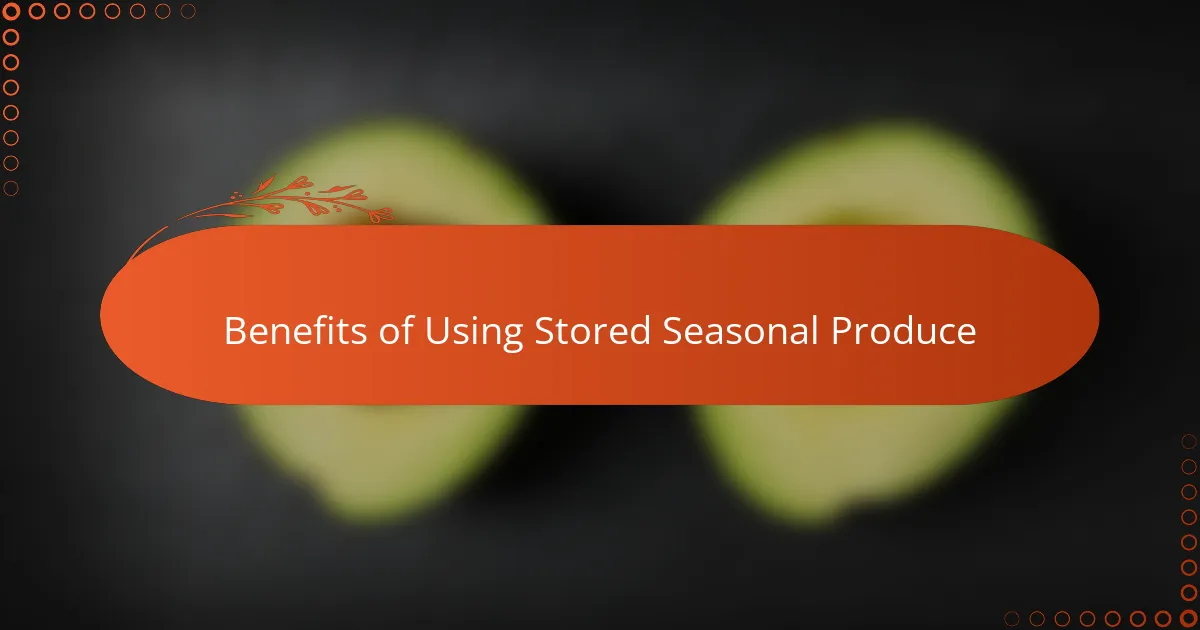
Benefits of Using Stored Seasonal Produce
Using stored seasonal produce has transformed how I experience home cooking throughout the year. There’s something deeply satisfying about knowing that the carrots or squash I’m reaching for were nurtured patiently and stored thoughtfully, unlocking flavors that fresh-picked items sometimes can’t match right off the vine. Have you ever noticed how apples sweeten and develop more complex aromas when stored properly? That subtle shift makes your dishes taste that much richer.
Besides flavor, I’ve found that relying on stored seasonal produce reduces food waste significantly. When I respect each item’s optimal storage conditions, I’m not frantically tossing spoiled vegetables every few days. This not only saves money but also gives me peace of mind—knowing my hard work in the garden or at the market isn’t going to waste. It’s empowering to cook confidently, trusting that my ingredients will hold up and deliver just when I need them.
Another benefit I appreciate is the convenience factor that comes with having a well-stocked pantry or cellar. On busy days, reaching for preserved beans, root vegetables, or stored fruits feels like a small victory. It keeps me connected to the seasons even when fresh options aren’t available, inspiring creativity in the kitchen without the stress of hunting down the right ingredients. Have you ever experienced that smooth flow of pulling out exactly what you need because you planned ahead? It’s a game changer.
